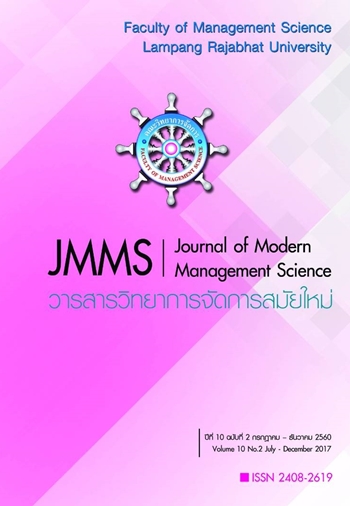A Community Market, Strength of Economic Foundation and a Starting Point of Logistics Process at the Community Level : A Case Study of Community Market at Chachoengsao Municipal Stadium, Mueang Chachoengsao District, Chachoengsao Province, Thailand
Main Article Content
Abstract
A community market is the unique resource of economic rotation in the local community, which is still charming and well-accepted by consumers among the growth and stiff competition from big malls, wholesalers, retailers, and convenience stores. The objectives of this study were 1) to study the context and analyze the amount of money spent on merchandise circulating through the community market held in the area of Chachoengsao Municipal Stadium, 2) to explore the database regarding the market's direct effects on the community’s economy, and 3) to examine the roles of community market influencing the strengthening of the community. The research instruments were interviews with entrepreneurs/merchants and officials of government agencies. The data of income from merchandising were collected from the records of the Market Committee. The target group to be studied was 203 merchants from two component markets: Community Enterprise Market, and the agricultural market, however, 159 merchants were selected to be studied in this research. The results of this research were: the community market consisted of Community Enterprise Market and Agricultural Market. The income from merchandising was 50 million baht per year; 40 million baht from permanent merchants of Community Enterprise Market, and 10 million baht from agriculturists selling agricultural products. The selling point to make this community market very popular is a variety of products from many local places. The products are also different according to the season and are not commonly found in department stores. In addition, most of the merchants are kind, friendly, and usually offer discount for customers as they made or brought the products from the origins by themselves. Since the products are sold on the traditional local temporary stalls, which are not commonly found in the city, it creates the fantastic atmosphere combining shopping and sightseeing and it is worth for visiting. The products are also healthy and certified by the official organization. Furthermore, the location of this community market is convenient and easy to access, close to government agencies, a hospital, and institutes. Transferring local products to the community market is the starting point of logistics process which helps strengthen the economic foundation for the community. Also, it is the association among upstream comprising of activities done by network of product makers in the community, midstream which is collecting, transporting, and distributing quality products to the community market, and downstream in which the consumers will be satisfied by with the fresh food and the price is reasonable, compared with the good quality. Due to the community market, people in the community will have jobs, income, and it also creates the economic rotation in the community, which is beneficial for career development, society, culture, and to increase sustainable living and reducing dependency
Article Details
The article must be considered and accepted for publication by the editorial board of the Faculty of Management Science, Lampang Rajabhat University. The articles have been reviewed by a peer (peer review) and the author must update according to the suggestion if available before publication. Articles that are not considered the editorial team will inform the results of the consideration but will not send the original to the author.
JMMS is the Faculty of Management Science journal, Lampang Rajabhat University. Jmms published both print and online editions. We allow the use of articles for academic use under the scope of copyright law.
References
คณะทำงานการพัฒนาเศรษฐกิจฐานรากและประชารัฐ. สืบค้นเมื่อ 8 มีนาคม 2560, จาก http://www. boi.go.th
/upload/ content.
ชาย โพธิสิตา. (2554). ศาสตร์และศิลป์แห่งการวิจัยเชิงคุณภาพ (พิมพ์ครั้งที่ 5). กรุงเทพฯ: อมรินทร์พริ้นติ้ง.
เดชาธร มนเทวิน. เหรัญญิกตลาดนัดเกษตรกร. สัมภาษณ์, 12 สิงหาคม, 27 ธันวาคม 2559.
นฤพนธ์ ด้วงวิเศษ. (2551). อะไรคือตลาด. บทความวัฒนธรรม แปลและเรียบเรียงจาก David Levinson
and Melvin Ember(eds.) Encyclopedia of Cultural Anthropology. Henry Holt and
Company, New York. Pp. 728-732. กรุงเทพฯ: ศูนย์มานุษยวิทยาสิริธร (องค์กรมหาชน).
สืบค้นเมื่อ 8 เมษายน 2560, จาก http://www.eighteggs. com/sac/article _detail.php?article_i d=16 & category_id=11.
บุญเรือง คำจันทร์. สัมภาษณ์, 14 มีนาคม 2560.
พุด ลอยรัตน์. สัมภาษณ์, 28 มีนาคม, 6 กรกฎาคม 2559.
ไรหนับ ศรีอาหมัด. (2555). ตลาดน้ำคลองแห : พื้นที่ประดิษฐ์เพื่อการท่องเที่ยวและการบริโภค. (วิทยานิพนธ์
ปริญญาศิลปศาสตรมหาบัณฑิต สาขาพัฒนามนุษย์และสังคมหาวิทยาลัยสงขลานครินทร์), สงขลา.
โลจิสติกส์. สืบค้นเมื่อ 8 มีนาคม 2560. จาก https://th.wikipedia.org/wiki/.
สารานุกรมเสรี. สืบค้นเมื่อ 7 มีนาคม 2560. จาก https://th.wikipedia.org/wiki/.
วีณา เจริญสุข. สัมภาษณ์, 12 กุมภาพันธ์ 2560.
วันเพ็ญ ดิษฐ์ศิริ. สัมภาษณ์, 20 มกราคม 2560.
คณะทำงานการพัฒนาเศรษฐกิจฐานรากและประชารัฐ. สืบค้นเมื่อ 8 มีนาคม 2560. จาก http:// www.boi.go.th/upload/content.pdf.
สายัณห์ โกมล. สัมภาษณ์, 15 กันยายน, 8 ธันวาคม 2558.
สารานุกรมไทยสำหรับเยาวชน.เล่มที่ 28 เรื่องที่ 3 ตลาด. สืบค้นเมื่อ 4 สิงหาคม 2560 ,
จาก http://saranukromthai.or.th/sub/book/book.php?book..
สินชัย ผดุงเจริญ. สัมภาษณ์, 25 ธันวาคม 2558.
สมรักษ์ ชัยสิงห์กานานนท์. (2549). บทนำ ตลาดในชีวิต ชีวิตในตลาด. กรุงเทพฯ: ศูนย์มานุษยวิทยา
สิรินธร (องค์การมหาชน).
Robinson, K. (2000). Economy as a cultural system: the economic anthropology of Paul
Alexander, Asia Pacific Journal of Anthropology, 1(1), 3-13.


